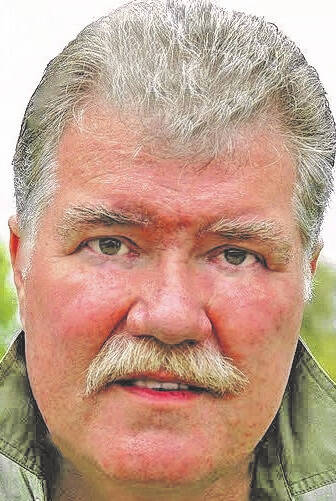
It was barely daybreak along the river when the dog and I stepped out the door. More dark than light, though somewhere beyond the low hill to the east, I knew the sun was climbing our way.
September’s soft, early-morning air was damp with a refreshing tinge of coolness and scented with just a hint of something decidedly autumnish … a whiff of things to come as summer exhales its final days.
Not a breath of wind stirred the dew-jeweled leaves and tall grass clumps.
All was hushed and serene.
Misty wisps, like threads of luminous silk, hung just above the nearby river’s dark pool — and when I held my breath and listened intently, in the moist silence I could hear the musical purling of water finding its way through the maze of riffle-stones.
Daisy was eager to get going and immediately headed off to check out her bailiwick and take care of doggie business.
I crossed to the far end of the porch and sat on the wooden bench, but looking around as I went — peering into the shadows, trying to make sure my pooch had the yard to herself.
I’ve learned the hard way to not assume we’re alone. That’s the thing about living here on the woodsy banks of the Stillwater — you just never know who you’ll surprise early in the morning.
Raccoon, possum, skunk, squirrel, cottontail, woodchuck, goose, duck, or prowling cat? Property lines, fences, and slow-moving streams mean nothing to these fellow denizens.
However, the last thing I need before I’ve had my morning coffee is a trespasser-routing hullabaloo — Daisy chasing the interloper, me chasing Daisy. Nope, without adequate caffeine fortification, I’m just not prepared for such slapstick bedlam.
A few mornings before, moments after Daisy had returned to the porch from her reconnoitering rounds, three whitetails splashed across the river from the island and bounded up the bank and into the yard.
My seat on the bench gave me a line-of-sight height advantage over Daisy’s lower-to-the-ground view — so I saw the deer coming before she did and had a split-second to react.
Thank goodness Daisy’s collar was within easy quick-grab reach!
For the next ten minutes, we watched together as the deer leisurely worked their way across the yard less than a hundred feet from where we sat. Daisy trembled with pent-up excitement but otherwise remained still and quiet.
The trio veered this way and that, investigating various bushes and plantings, pausing intermittently, alert, heads up, ears twitching like semaphore flags, to look around for possible danger. Miraculously, they somehow failed to detect our presence — and eventually, worked their way up the driveway hill, crossed the road, and trotted around the back of the neighbors’ house.
Daisy relaxed. Out of sight, out of mind. I loosened my grip and she went over to snuffle along the path the deer had taken through “her” yard.
Though it took a while, the sun eventually deigned to appear. Golden light burnished the tiptops of the island’s tall sycamores across the channel.
September mornings are simply splendid — and now, even in my modest yard, wherever you look, it’s impossible to miss how things are truly changing as time and season keep moving briskly along.
The metamorphosis begins with a shift in color. Roadside blooms slowly move from August’s pinks and whites and pale yellows to the strong, vibrant hues of autumn. September is always a memorable dazzle of purple and gold — from the legion of asters to the bold swathes of goldenrod and the spatters of purple-blue vervain.
The strident buzzing of backyard cicadas has silenced. And the winking yellow lanterns of twilight’s myriad fireflies have flickered out.
Monarchs are fluttering southward, on their long, precarious odyssey to Mexico.
Crickets chirp now in the waning heat of afternoon.
Katydids are beginning to fiddle in the night which — according to folklore — means our first frost will appear in less than six weeks.
But seasons never spring into being overnight. They slip upon us like a cat stalking through the tawny grass, or a shadow creeping across the lawn.
Yet that change is also deliberate — though often with much sputtering back and forth between the moods of yesterday and temperaments of tomorrow, like a guest reluctant to leave but eager to be on the road.
That we so often fail to notice these changing times probably says more about our lack of attention — our increasing disconnection with the natural world—than it does about any subtlety on the part of the seasonal shifting.
Nevertheless, the signs are always there for those who look.
Locally, a few sumacs have already picked up the call to colorize and commenced donning brilliant cloaks of flaming red.
You can also bet on soon seeing the first of the Virginia creeper’s scarlet fires twinning up old roadside poles and the trunks of fenceline trees.
In the remote hill country, the rambler has a fair possibility of discovering fringed gentian, a rare plant with flowers so intensely blue that Thoreau once described their color as “surpassing that of a male bluebird’s back.”
Hickories are going rusty yellow. In weeks to come their color changes will be echoed throughout Ohio’s woodlands — by oak and maple, woodbine and cherry, ash and elm. These and a hundred other species will blaze with autumn’s cool fires.
Once this ninth month arrives, in typical fashion it soon begins setting itself apart from its hot-weather predecessors. And that annual show has unquestionably begun.
Sitting on the front porch with my dog, seeing another new day dawn, I’m excited about getting to watch it all happen.
Reach Jim McGuire at [email protected].

